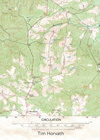Circulation
In his introspective novella Circulation, Tim Horvath devotes special attention to examining the grey areas of modern life where reality and fantasy often meet and the distance between life and death dwindles. In what would best be described as character self-development, Horvath brings the reader face to face with the narrator Jay's dual preoccupations of family connection and recorded knowledge. The self examining nature of Circulation presents the reader with a sympathetic look at these twin pillars of the protagonist's identity, even as Jay begins to slowly tear them down.
In his introspective novella Circulation, Tim Horvath devotes special attention to examining the grey areas of modern life where reality and fantasy often meet and the distance between life and death dwindles. In what would best be described as character self-development, Horvath brings the reader face to face with the narrator Jay's dual preoccupations of family connection and recorded knowledge. The self examining nature of Circulation presents the reader with a sympathetic look at these twin pillars of the protagonist's identity, even as Jay begins to slowly tear them down.
Like an heir who has not yet grown into his estate, Jay has been unable to make sense of his dwindling familial relationships. With his real connections all but severed, his legacy consists of a dying father's unfulfilled vision of a recordable world, one that can be replicated and indexed within a single binding: “The Atlas would chart the voyages of things, as heroic . . . as the boldest venture in the Age of Exploration.” The grandioseness that makes this task heroic also makes it impossible. The perfect task for later, as it can never be completed by any one man or tribe. However, like his father, Jay has a hard time dealing with impossibility, only slowly realizing that that book could never have been written: “Unwritten, perhaps unwritable . . . that ideal version of that book; once one admitted the impossible, one might as well usher in its unruly companions.” Forced to confront the influence that this naïve vision has had over him since childhood, Jay undertakes the task of redrawing the outlines of his world before the old ones disappear.
As his father's health fails, Jay revisits his childhood where he began associating written history with family history. Musing on the connection, he remembers the questions it aroused in his youth, “Do all families have such unifying themes? And if not what replaces them? How, otherwise, do they make sense of it all, bring together the noblest and basest in their histories within a single binding.” Of course, such a cleanly bound family has never actually existed. As the novel progresses, Jay realizes that such a vision of family life, like the unifying atlas of his father’s obsessive imagination, could never be realized – that his embrace of fantasy necessarily denied a part of reality. However, as is often the case with illusions, once put into perspective they can be illuminating. Yet such demystifying is not easy, constructions of the mind do not just fade away; they must be replaced, invalidated, or synthesized with new experiences and insights. Like the myth of the omniscient library, “that essentially comprises the whole universe – the universe as library,” the myth of the omnipresent parent is only a distracting antidote to reality as even “the greatest libraries of civilizations burn down, suns collapse, abandon planets without child support.” It is in the darkness of abandonment where Jay must venture and find his way in the world.
In the darkness, Jay begins to “realize that the truth is precisely the wrong instrument for the task,” of putting his family's history to rest. It is in fiction that he finally finds the tool to confront the reality of our age – that history is always in flux, always being rewritten, vanishing and reappearing every day. Like Jay, Horvath uses his fiction to expose the tension between reality and fantasy in modern life. The uncertainty between where one begins and the other ends is used to explore the ever changing way in which we as a people define and record the facts. In questing after the facts, Circulation gives the reader a chart to navigate a reality clearly inherited, but less clearly defined.





